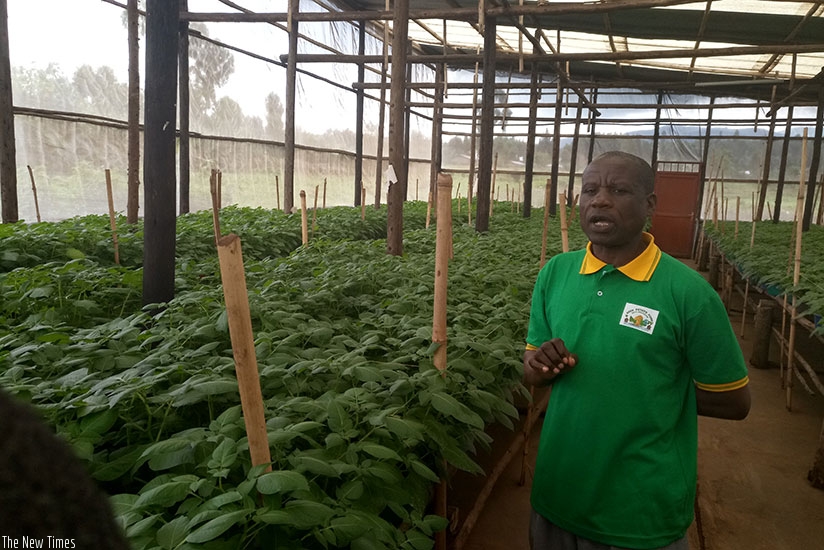It’s about noon on Tuesday and Isaac Nzabarinda stands in his quarter-hectare greenhouse where he is busy explaining how Irish potato seeds are produced and multiplied from small pieces of plant tissue (vitroplant) in a laboratory to minitubers, up to the certified seeds distributed to farmers.


It’s about noon on Tuesday and Isaac Nzabarinda stands in his quarter-hectare greenhouse where he is busy explaining how Irish potato seeds are produced and multiplied from small pieces of plant tissue (vitroplant) in a laboratory to minitubers, up to the certified seeds distributed to farmers.
His greenhouse has capacity to generate some 60,000 potato minitubers which are grown on over one-hectare land to produce over 12 tonnes of seeds given to farmers for cultivation to get Irish potatoes for consumption.
Nzabarinda is also the president of Irish Potato Platform, an organisation that brings together potato farmers, multipliers and dealers.
But, Nzabarinda pointed out that seed production and multiplication cycle takes about 40 months (three years) to yield.
The greenhouse project started in 2012, Nzabarinda noted, adding that so far countrywide, there are about 20 greenhouses owned by private entrepreneurs in farming sector.
Strides forward
Speaking about the importance of this development, Nzabarinda said that in 2012 farmers could only get two percent of certified seeds from Rwanda Agriculture Board (RAB).
The remaining 98 percent of the needed seeds was obtained informally with some of them being imported, which sector players argue was detrimental to agricultural produce as they were often affected by diseases and lacked quality.
But currently, the certified seeds supplied to farmers account for 25 percent.
Certified seeds are being sold at about Rwf400 to Rwf450 a kilogramme, according to Nzabarinda.
To ensure quality of seeds, he appealed to anyone engaged in seed multiplication "to uphold values including honesty and professionalism so that they provide farmers with productive and standard seed.”
"We are putting more efforts in multiplication of quality Irish potato seeds such that we target to meet farmers’ seed demand in three years’ time,” Nzabarinda observed.
The Seed Potato Fund (SPF) manager, Solomon Mbarushimana concurred with Nzabarinda that they target to satisfy quality seed demand in three years.
SPF was established in 2015 by private investors in the agriculture sector, with support of RAB.
He pointed out that the fund started with about Rwf200 million, but currently, it has about Rwf2 billion.
In Season B of the forthcoming 2017/2018 farming year, he said, quality Irish potato seeds distributed among farmers will be 30,000 tonnes.
For seeds to be available, it takes about eight months as Irish potatoes take about four months to be harvested and four-month dormancy period to become seeds.
This cycle, Mbarushimana said, was a challenge to Irish potato seed multipliers because they had difficulties getting funds to reinvest in seed multiplication business as they would wait for about eight months to get paid.
Alphonse Rwamagana, 60, is an Irish potato farmer in Musanze District. He grows the crop on almost one-hectare piece of land where he harvests between 15 and 20 tonnes per season (about four months).
Underscoring the importance of this initiative consisting of multiplying seeds through greenhouse, he said that it enable farmers to get certified seeds which give them enough yields and are free from disease.
He told The New Times that besides producing for the market, Irish potato constitutes the main ingredient in the region (Musanze) residents’ daily diet.
Currently, a farmer gets between Rwf180 and 200 per kilogramme of Irish potato.
"Farmers have been importing seeds from neighbouring countries, but such seeds turned out to be diseased and therefore made farmers encounter losses. The seeds produced from greenhouses are free from disease because they are under a controlled environment and protected against extraneous pathogenic agents,” he said.
Amina Umutoni, another Musanze District farmer, has been cited among the large scale Irish potato growers in the district. She grows the crop on 40 hectares close to Sabyinyo Volcano.
Her produce per hectare is higher than all the farmers in the district, as she harvests between 38 and 42 tonnes per hectare, while other farmers largely get between 10 to 20 tonnes per hectare.
Mbarushimana said that Umutoni was given a license for the multiplication of seeds and her contribution will be important given that she multiplies them on a larger piece of land.
Umutoni attributed her impressive yields to good farming practices including fertiliser application, weeding and pesticide spraying, adding that she employs about 600 workers whom she pays between 1,200 and 2,000 per day.
RAB’s head of Crop Intensification Programme (CIP) in Musanze District Monique Uwamahoro said that having farmers like Umutoni who practice Irish potato farming at large scale, is crucial in achieving seed targets, food security and scaling up the economy
In January, 2017, the head of RAB’s Northern Province Zone, Jean Claude Izamuhaye, had told The New Timest hat the production capacity of the Musanze-based potato laboratory was increased tenfold from 80,000 plantlets to 800,000 per season, which will generate about 21,510 tonnes of Irish potato seeds to be distributed to farmers.
He added that in September 2017, certified seeds to farmers are projected to reach 25 percent, while they are expected to be 75 percent by 2020.
Figures from RAB showed that in agriculture season 2017 A, Irish potato was grown on 63,274 hectares countrywide, with expected production of over 1.2 million tonnes based on average produce of 20 tonnes per hectare.
editorial@newtimes.co.rw


